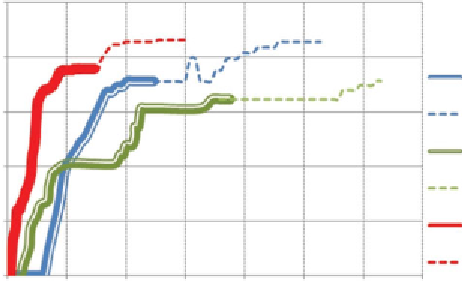Environmental Engineering Reference
In-Depth Information
4.2
Electrically Enhanced Oil Recovery (EEOR) -
EK Assisted WF
Many waterflooding operations in carbonates present serious problems
because of the plugging of pores by clays, bacteria, etc. Even greater prob-
lems occur in tight carbonate rocks, i.e., when water “does not move in”. By
applying DC current, the water moves in much better (e.g., see figure 4.1
and figure 4.2).
This increase in the oil recovery obtained from application of DC elec-
trokinetics can be explained due to the hydrodynamic flow supported by
the electrokinetic flow, which is the motion of liquid induced by an applied
potential across a porous material, capillary tube, membrane, micro chan-
nel, or any other fluid conduit. This electrokinetic phenomenon is signifi-
cantly enhanced when the flow takes place across small conduits especially
in oil-wet reservoirs where most of the oil is by-passed.
The increment in displacement efficiency of about 10-17% results in an
increase in residual water saturation of about 4-17%. This is due to the
decrease in oil saturation in the cores as the core plug turns into water-wet
from an oil-wet initially.
The average reservoir flow rate of 0.1 ml/min was used corresponding to
the average flow rate of 1 ft/Day in carbonate reservoirs. It was shown that
a lower flow rate of 0.1ml/min yielded higher oil displacement efficiency
100
80
Core - 6 - WF
60
Core - 6 - (WF + EK)
Core - 7 - WF
40
Core - 7 - (WF + EK)
20
Core - 8 - WF
Core - 8 - (WF+EK)
0
0
2
4 6
Number of injected pore volumes
8
10
12
14
Figure 4.1
Displacement Efficiency (%) versus number of injected pore volumes in
experiments conducted on a 1-in core at a flow rate of 0.1 ml/min.
















Search WWH ::

Custom Search